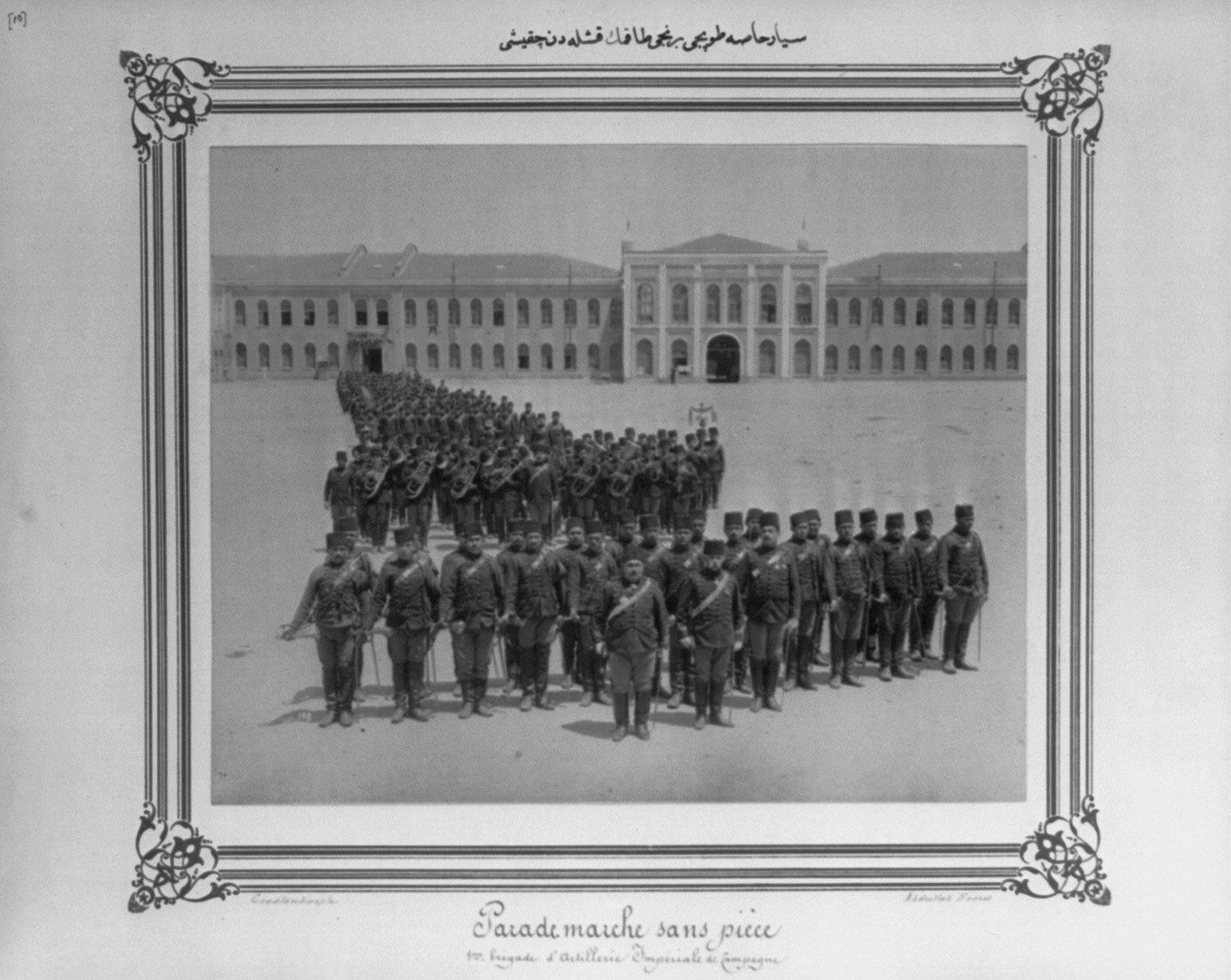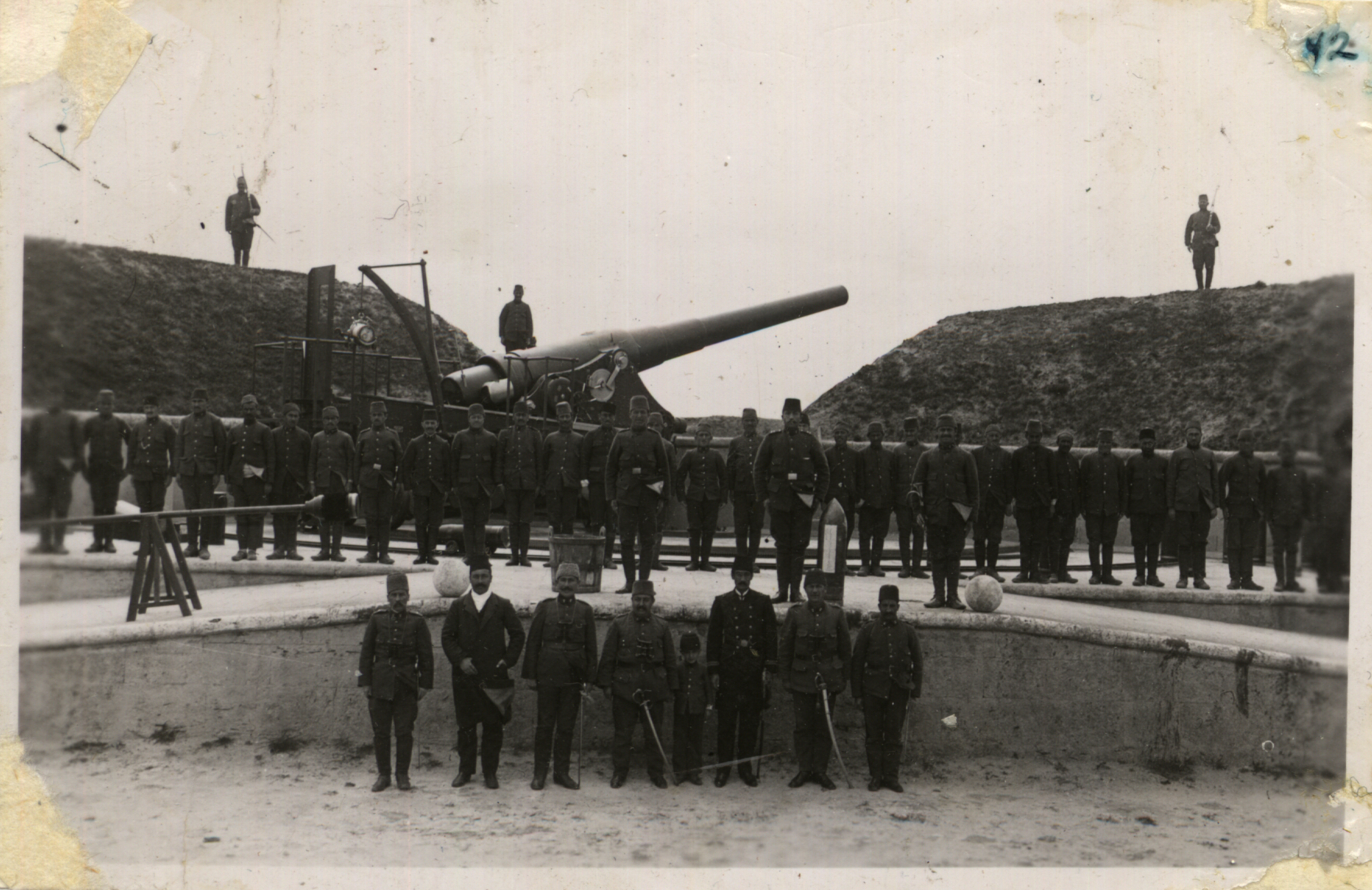|
First Army (Ottoman Empire)
The First Army or First Guards Army of the Ottoman Empire ( Turkish: ''Birinci Ordu'' or ''Hassa Ordusu'') was one of the field armies of the Ottoman Army. It was formed in the middle 19th century during Ottoman military reforms. Formations Order of Battle, 1877 In 1877, it was stationed in Selimiye. It was composed of: *Infantry: Seven line regiments and seven rifle battalion.Ian Drury, Illustrated by Raffaele Ruggeri, ''The Russo-Turkish War 1877'', Men-at-Arms 277, Ospray Publishing Ltd., Reprinted 1999, , p. 35. **1st Regular Infantry Division (''Birinci Nizamiye Fırkası'')Edward J. Erickson, ''Defeat in Detail: The Ottoman Army in the Balkans, 1912-1913'', Westport, Praeger, 2003, p. 6. **2nd Regular Infantry Division (''İkinci Nizamiye Fırkası'') *Cavalry: Five line regiments and one Cossack brigade. **Cavalry Division (''Süvari Fırkası'') *Artillery: Nine field and three horse batteries, one İhtiyat regiment. **Artillery Division (''Topçu Fırkası'') *Engine ... [...More Info...] [...Related Items...] OR: [Wikipedia] [Google] [Baidu] |
Field Army
A field army (or numbered army or simply army) is a military formation in many armed forces, composed of two or more corps and may be subordinate to an army group. Likewise, air armies are equivalent formation within some air forces, and within a navy the comparable notion is that of a fleet. A field army is composed of 300,000 to 600,000 troops. History Specific field armies are usually named or numbered to distinguish them from "army" in the sense of an entire national land military force. In English, the typical orthographic style for writing out the names field armies is word numbers, such as "First Army"; whereas corps are usually distinguished by Roman numerals (e.g. I Corps) and subordinate formations with ordinal numbers (e.g. 1st Division). A field army may be given a geographical name in addition to or as an alternative to a numerical name, such as the British Army of the Rhine, Army of the Potomac, Army of the Niemen or Aegean Army (also known as the Fourth Army ... [...More Info...] [...Related Items...] OR: [Wikipedia] [Google] [Baidu] |
Dardanelles Fortified Area Command
The Dardanelles Fortified Area Command or Mediterranean Strait Fortified Area Command or Çanakkale Fortified Area Command (Turkish: ''Bahr-i Sefîd Boğazı Mevki(i) Müstahkem Komutanlığı'' or ''Akdeniz Boğazı Müstahkem Mevki(i) Komutanlığı'' or ''Çanakkale Boğazı Müstahkem Mevki(i) Komutanlığı'' or ''Çanakkale Müstahkem Mevki(i) Komutanlığı'') was the Ottoman fortified area command and was formed to defend against attacks on the Dardanelles from the Aegean Sea. Formations Order of Battle, 1911 With reorganizations of the Ottoman Army, to include the creation of corps level headquarters, by 1911 the fortified area command was headquartered in Çanakkale, under the command of II Corps. The Dardanelles Fortified Area Command in 1911 was structured as such: Dardanelles Fortified Area Command, Çanakkale *3rd Heavy Artillery Regiment *4th Heavy Artillery Regiment *5th Heavy Artillery Regiment *Independent Heavy Artillery Regiment *Torpedo Detachment *Mine D ... [...More Info...] [...Related Items...] OR: [Wikipedia] [Google] [Baidu] |
Tekirdağ
Tekirdağ (; see also its other names) is a city in Turkey. It is located on the north coast of the Sea of Marmara, in the region of East Thrace. In 2019 the city's population was 204,001. Tekirdağ town is a commercial centre with a harbour for agricultural products (the harbour is being expanded to accommodate a new rail link to the main freight line through Thrace). It is also home to Martas and the BOTAŞ Terminal, both of them important for trade activities in the Marmara Region. The town's best known product remains Tekirdağ rakı although it is also known for its cherries, celebrated with a festival every June. The proximity of the Greek and Bulgarian borders means that there are honorary consulates for both countries in Tekirdağ town. Ferries from Tekirdağ sail to the nearby Marmara Islands during the summer. The nearest airport is Tekirdağ - Çorlu Airport (TEQ) although there are many more flights to Istanbul International Airport (IST). Names and etymology ... [...More Info...] [...Related Items...] OR: [Wikipedia] [Google] [Baidu] |
II Corps (Ottoman Empire)
The II Corps of the Ottoman Empire (Turkish: ''2 nci Kolordu'' ''or'' ''İkinci Kolordu'') was one of the corps of the Ottoman Army. It was formed in the early 20th century during Ottoman military reforms. Formation Order of Battle, 1911 With further reorganizations of the Ottoman Army, to include the creation of corps level headquarters, by 1911 the II Corps was headquartered in Tekfur Dağı. The Corps before the First Balkan War in 1911 was structured as such:Edward J. Erickson, ''Defeat in Detail, The Ottoman Army in the Balkans, 1912–1913'', Westport, Praeger, 2003, pp. 372–373. *II Corps, Harbiye, Tekfur Dağı (Mirliva Şevket Turgut Pasha) ** 4th Infantry Division, Tekfur Dağı (Mirliva Hıfzı Pasha) ***10th Infantry Regiment, Tekfur Dağı ***11th Infantry Regiment, Tekfur Dağı ***12th Infantry Regiment, Hayrabolu ***4th Rifle Battalion, Tekfur Dağı ***4th Field Artillery Regiment, Tekfur Dağı ***4th Division Band, Tekfur Dağı ** 5th Infantry Division ... [...More Info...] [...Related Items...] OR: [Wikipedia] [Google] [Baidu] |
Bosporus Fortified Area Command
The Bosporus Strait (; grc, Βόσπορος ; tr, İstanbul Boğazı 'Istanbul strait', colloquially ''Boğaz'') or Bosphorus Strait is a natural strait and an internationally significant waterway located in Istanbul in northwestern Turkey. It forms part of the continental boundary between Asia and Europe, and divides Turkey by separating Anatolia from Thrace. It is the world's narrowest strait used for international navigation. Most of the shores of the Bosporus Strait, except for the area to the north, are heavily settled, with the city of Istanbul's metropolitan population of 17 million inhabitants extending inland from both banks. The Bosporus Strait and the Dardanelles Strait at the opposite end of the Sea of Marmara are together known as the Turkish Straits. Sections of the shore of the Bosporus in Istanbul have been reinforced with concrete or rubble and those sections of the Strait prone to deposition are periodically dredged. Name The name of th ... [...More Info...] [...Related Items...] OR: [Wikipedia] [Google] [Baidu] |
Kara Harp Okulu
The Turkish Military Academy ( tr, Kara Harp Okulu) is a four-year co-educational military academy and part of the National Defence University. It is located in the center of Ankara, Turkey. Its mission is to develop cadets mentally and physically for service as commissioned officers in the Turkish Army, and is the oldest of the academies of the Armed Forces (opened 1834). After 2016 Turkish coup d'état attempt Military academy (along with Naval Academy, Air Force Academy and all the other military educational institutions) became part of the new National Defence University which is formed under Ministry of National Defence. Entry process There are roughly 4,000 cadets attending the Turkish Military Academy at any one time. In order to enter the academy, prospective cadets must graduate from a high school then pass necessary exams and various tests. Only students displaying the potential to become officers are accepted. The Academy is the only source of commissioned offi ... [...More Info...] [...Related Items...] OR: [Wikipedia] [Google] [Baidu] |
Hasan Izzet
Hasan Izzet Pasha ( Turkish: ''Hasan İzzet Paşa'', ''Hasan İzzet Arolat'', 1871; Constantinople (Istanbul) – 3 March 1931, ailemiz. net, information from the Archive of the Personnel Department of Turkish Army ) was a Turkish general of the Ottoman Empire. Early life Hasan Izzet Born in a family of Turkish origin1871 to mother Süreyya Hanım and father Ali Muhsin Pasha in Aksaray neighborhood of Istanbul. He graduated from the Ottoman Military Academy (''Mekteb-i Füsûn-u Harbiyye-i Şâhâne'') in 1890 and the Staff College (''Mekteb-i Erkân-ı Harbiye-i Şâhâne'', present day: Harp Akademisi) on 23 March 1893 as a Staff Captain (''Erkân-ı Harp Yüzbaşısı''). Military career He was appointed to the fourth department of the General Staff by the order of Sultan Abdülhamid II on 14 April 1894. On 7 May 1895, he was promoted to the rank of Senior Captain (''Kolağası'') and on 12 May 1895, he participated in the military staff excursion to Üsküp (present ... [...More Info...] [...Related Items...] OR: [Wikipedia] [Google] [Baidu] |
I Corps (Ottoman Empire)
The I Corps of the Ottoman Empire ( Turkish: ''1 nci Kolordu'' ''or'' ''Birinci Kolordu'') was one of the corps of the Ottoman Army consisting of ethnic Albanians. It was formed in the early 20th century during Ottoman military reforms Formation Order of Battle, 1911 With further reorganizations of the Ottoman Army, to include the creation of corps level headquarters, by 1911 the I Corps was headquartered in Harbiye. The Corps before the First Balkan War in 1911 was structured as such: *I Corps, Harbiye, Constantinople ( Ferik Zeki Pasha) ** 1st Infantry Division, Harbiye, Constantinople ***1st Infantry Regiment, Harbiye, Constantinople ***2nd Infantry Regiment, Bakırköy, Constantinople ***3rd Infantry Regiment, İşkodra ***1st Rifle Battalion, Taksim, Constantinople ***1st Field Artillery Regiment, Taksim, Constantinople ***1st Division Band, Harbiye, Constantinople ** 2nd Infantry Division, Selimiye, Constantinople (Mirliva Prens Aziz Pasha) ***4th Infantry Regiment, ... [...More Info...] [...Related Items...] OR: [Wikipedia] [Google] [Baidu] |
First Balkan War
The First Balkan War ( sr, Први балкански рат, ''Prvi balkanski rat''; bg, Балканска война; el, Αʹ Βαλκανικός πόλεμος; tr, Birinci Balkan Savaşı) lasted from October 1912 to May 1913 and involved actions of the Balkan League (the Kingdoms of Kingdom of Bulgaria, Bulgaria, Kingdom of Serbia, Serbia, Kingdom of Greece, Greece and Kingdom of Montenegro, Montenegro) against the Ottoman Empire. The Balkan states' combined armies overcame the initially numerically inferior (significantly superior by the end of the conflict) and strategically disadvantaged Ottoman armies, achieving rapid success. The war was a comprehensive and unmitigated disaster for the Ottomans, who lost 83% of their European territories and 69% of their European population. [...More Info...] [...Related Items...] OR: [Wikipedia] [Google] [Baidu] |
Harbiye, Şişli
Harbiye is a neighbourhood of Şişli, Istanbul, Turkey. The neighbourhood takes its name from the ''Mekteb-i Harbiye'' ( Ottoman War Academy) that functioned here for many years, albeit with intervals, in the 19th and 20th centuries. Harbiye is separated from Kurtuluş to the west by busy Cumhuriyet Caddesi (Independence Street). To its north are the upmarket neighbourhoods of Nişantaşı and Teşvikiye, while to its east is leafy Maçka. To its south are the heavily built-up Elmadağ and Taksim neighbourhoods. The nearest Metro station to Harbiye is Osmanbey on the M2 line but many buses and dolmuşes plough up and down Cumhuriyet Caddesi. Attractions Harbiye's most important tourist attraction is the Military Museum (Askeri Müzesi) which is housed in the buildings of the old ''Mekteb-i Harbiye'' ( Ottoman War Academy. It contains a fine collection of embroidered Ottoman war tents and paintings by the war artist Hasan Rıza Bey. It also preserves a classroom where Ata ... [...More Info...] [...Related Items...] OR: [Wikipedia] [Google] [Baidu] |
Kayseri
Kayseri (; el, Καισάρεια) is a large Industrialisation, industrialised List of cities in Turkey, city in Central Anatolia, Turkey, and the capital of Kayseri Province, Kayseri province. The Kayseri Metropolitan Municipality area is composed of five districts: the two central districts of Kocasinan and Melikgazi, and since 2004, also outlying Hacılar, İncesu, Kayseri, İncesu and Talas, Turkey, Talas. As of 31 December 2021, the province had a population of 1,434,357 of whom 1,175,886 live in the four urban districts, excluding İncesu, Kayseri, İncesu which is not conurbated (i.e. not contiguous, having a largely non-protected buffer zone). Kayseri sits at the foot of Mount Erciyes (Turkish language, Turkish: Erciyes Dağı), a dormant volcano that reaches an altitude of , more than 1,500 metres above the city's mean altitude. It contains a number of historic monuments, particularly from the Seljuk dynasty, Seljuk period. Tourists often pass through Kayseri en rout ... [...More Info...] [...Related Items...] OR: [Wikipedia] [Google] [Baidu] |



